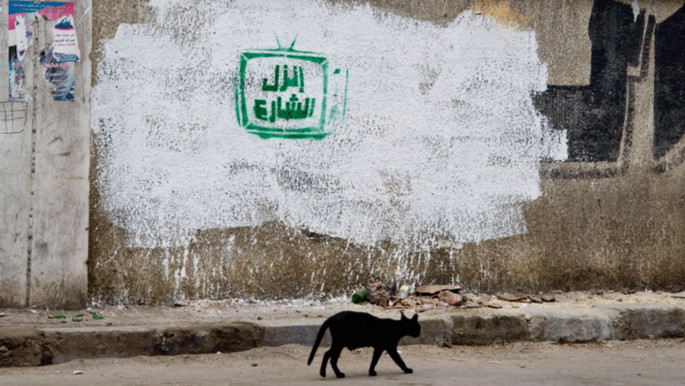Hope in a spraycan: Egypt's street artists keep tagging
Egyptian graffiti artist Adham Bakry has officially hung up his spraycans - at least for now.
The 32-year-old sustained a life-threatening injury last year - but he doesn't keep up with his art form primarily because of the crackdown on free speech under President Abdel Fattah al-Sisi's leadership.
"The last time I think was on 30 June," he said.
"I went around spraying the word 'sheep' [used as a pejorative term for Muslim Brotherhood members] and my stencil 'take to the streets' on walls in Port Said."
The date he mentions, 30 June 2013, saw huge protests which culminated in a military coup, overthrowing Brotherhood figurehead Mohammed Morsi's elected government.
 |
|
| 'Take to the streets' [Photo courtesy of artist] |
"During Morsi's days, it got easier - but now it's almost impossible," Bakry said.
"It's not even the police that you should be afraid of, it is random citizens who are not accepting the idea of protest in general."
Reactive and revolutionary
Art critic Soraya Morayef has diligently documented the work of Egypt's spraycan artists. "Graffiti has embedded itself in the Egyptian consciousness and that's something you can't undo," she said.
"A lot of street art appeared during the revolution - but it's much more than that. It's an underground culture that's been brewing for decades. A lot of academics argue about its genealogy tracing it back even to the 1919 revolution."
Morayef said that street art was reactive in its mode of conceptualisation, dealing with the political landscape. Imprinting a new mural on a wall suggests the writing of new histories and the remembrance of those who died.
| Egypt's revolution, four years on: Catch up with all of al-Araby's special coverage here |
In November 2011, 45 protesters were killed and more than 2,000 injured in fierce street fighting with security forces who violently dispersed a sit-in of relatives of those who had died at the start of the revolution in January 2011.
Snipers reportedly targeted protesters' eyes in what came to be known as "The Battle of Mohamed Mahmoud Street". Ahmed Harara lost both of his, and has to many become a symbol of the bravery of the revolutionaries.
Commemorating their deaths a year later, when President Mohammed Morsi was in power, two more were killed - including 17-year-old Mohamed Gaber, also known as Gika, whose portrait adorns several murals in downtown Cairo.
"Graffiti reacts to violence and repression, and when you whitewash it, that's when you create a new layer," said Morayef.
 |
|
| Some graffiti calls for the former information minister, Safwat al-Sherif, to be jailed |
Egyptian authorities have frequently painted over the walls in Mohamed Mahmoud Street, and artists have, each and every time, created new works in an important public space.
Street art as a collective endeavour
Hana el-Daghem is a 38-year-old visual artist based between Cairo and Berlin. She says it was the collective spirit of a group of artists painting together drew her to street art.
"I was in Berlin and I felt like I needed to participate on the street," she told al-Araby al-Jadeed.
"I contacted some artist friends of mine and they told me about spray painting. They said that what they were doing was being with people out on the street, so I started at the end of 2011 with stencils in Berlin in solidarity with other artists in Egypt."
However, the pull of the iconic street and fomenting an important tribute to revolutionaries drew Daghem to Egypt, where she went to Mohamed Mahmoud in early Feburary 2012.
"At first I started doing the backgrounds with other artists, eventually linking the different murals together.
 |
|
| 'Pyramid of crises' [Photo: Suzee In The City blog] |
"We wanted to make it effective as a whole, as a unit, with the diversity of three artists working together and linking events with each other.
"It wasn't chronological - every day it became an organic process, but it was an important experience for me."
As the fourth anniversary of the start of the Egyptian revolution passed on January 25, glimmers of optimism amid the artistic community are still present - despite all the political setbacks.
"I've started talking to the same artists again," said Daghem.
"There's some division among visual artists now - but we can work together again to bring back the same spirit.
"I want to go out again so we can unite again, so we can produce something beautiful again amid all the ugliness."



